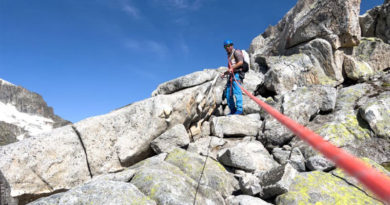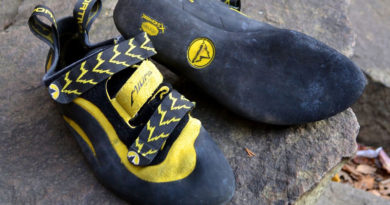Sport vs. Top Rope Climbing: A Comparison
Sport climbing and top rope climbing are two different styles of rock climbing. They vary in terms of techniques, equipment, and physical and mental demands.
Sport climbing involves lead climbing, where the climber ascends the route while clipping into fixed anchors (bolts) along the way. As the climber ascends, the belayer, who is positioned at the bottom, offers support and takes up the slack. The goal is to reach the top of the route without falling. Falls are usually guarded by a rope clipped into the bolts.
Top rope climbing, on the other hand, involves climbing a route with the rope already anchored at the top. The climber is tied to the rope from below, and the belayer takes up slack from above. Top rope climbing aims to reach the route’s top, although falls are often less serious because the rope provides a high amount of protection.
In terms of physical and mental demands, sport climbing requires a higher level of endurance, strength, and mental toughness due to the possibility of falls and the need for quick thinking and problem-solving on the route. Top rope climbing is often considered a more relaxed and less physically demanding style of climbing. The rope provides a high level of protection and allows for a less intense climbing experience.
Techniques and Equipment
Following are the tools and techniques used in the two types of climbing:
Sports Climbing
Sport climbing involves a specific set of techniques and equipment designed to support the climber as they ascend a route. Some of the key methods and equipment used in sport climbing include:
Lead Climbing
In lead climbing, the climber ascends the route while clipping into fixed anchors (bolts) along the way. The objective is to reach the top of the route without falling.
Bolts and Quickdraws
Bolts are fixed anchors that are placed into the rock along the route. The climber clips their rope into these bolts using quickdraws. Quickdraws are devices that consist of two carabiners connected by a sling. They allow the climber to quickly and easily clip into the bolts.
Belaying Techniques
The belayer is responsible for managing the rope and providing support to the climber. In sport climbing, the belayer must be able to quickly and smoothly take in the slack as the climber ascends. They must be able to lock off the rope in the event of a fall. Standard belaying techniques used in sport climbing include the Grigri and the manual belay device.
Climbing Shoes
Climbing shoes play a crucial role in sport climbing. They provide the climber with the necessary grip and precision to navigate the route. Climbing shoes are typically designed to be snug-fitting and to allow the climber to feel and apply pressure to small holds.
Helmets
While not mandatory, helmets are highly recommended in sport climbing due to the potential for falling rock and other hazards.
In addition to these key techniques and equipment, sport climbers may use chalk to dry their hands, slings, and quickdraws for anchor building, and personal safety equipment such as a harness and belay device.
Top Rope Climbing
Top rope climbing involves a different set of techniques and equipment compared to sport climbing. Some of the key methods and equipment used in top rope climbing include:
Anchor Setup
In top rope climbing, the rope is anchored at the top of the route, and the climber is attached to the rope from the bottom. The anchor setup is critical for top rope climbing. It must be secure and able to support the weight of the climber in the event of a fall.
Top Rope Belaying Techniques
The belayer is responsible for managing the rope and providing support to the climber. In top rope climbing, the belayer must be able to smoothly take in the slack as the climber ascends. They must be able to lock off the rope in the event of a fall. Ordinary top rope belaying techniques include the use of a belay device and the Munter hitch.
Helmets
While not mandatory, helmets are highly recommended in top rope climbing due to the potential for falling rock and other hazards.
Harnesses
Harnesses are essential in top rope climbing. They provide a secure connection between the climber and the rope. A climbing harness is typically adjustable and features various loops and gear loops for attaching equipment.
Carabiners
Carabiners are used to connect the rope to the harness and the anchor. They must be strong, lightweight, and easy to use.
Top rope climbers may additionally employ slings and quickdraws for anchor building. It also includes personal safety equipment like a belay device, in addition to these basic techniques and equipment.
Physical and Mental Demands
Due to the potential of falls and the need for quick thinking and problem-solving on the route, sport climbing requires a high level of physical endurance, strength, and mental toughness. You must be able to focus and concentrate for extended periods. You also need to withstand the physical demands of sustained climbing. The lead climber must also have good rope management skills and the ability to make quick decisions in the event of a fall.
Top rope climbing, on the other hand, is frequently regarded as a relaxed and less physically demanding type of climbing. The rope offers excellent protection, allowing climbers to concentrate on technique and mobility without the extra stress of falls. Top rope climbing is a fantastic choice for individuals looking for a less rigorous climbing experience. It is also a good option for those who are new to the sport and are still working on their strength and endurance.
Advantages and Disadvantages
The followings are the advantages and disadvantages of these two activities:
Advantages of Sport Climbing
Sport climbing is a physically and mentally challenging form of climbing that provides a unique set of advantages. Firstly, sport climbing requires a high level of mental focus, decision-making, and problem-solving. This makes it a mentally challenging and rewarding experience for climbers. This mental challenge helps climbers develop their problem-solving skills. It also provides a sense of satisfaction and accomplishment when the route is completed successfully.
Secondly, sport climbing requires a high level of physical endurance. You must be able to climb for extended periods without resting. This endurance training can be beneficial for improving overall fitness and health. It can also help climbers build strength and improve their technique.
Thirdly, sport climbing is a great way to develop technical climbing skills. You must navigate challenging routes and make quick decisions in real-time. This skill development is crucial for climbers who are looking to progress and push their limits. It also helps build confidence and competence in the sport.
Finally, sport climbing often involves exploring new areas and pushing one’s limits, leading to a sense of adventure and excitement. This sense of adventure and exploration is one of the key reasons why many climbers enjoy sport climbing.
Disadvantages
While sport climbing provides many advantages, it also has its own set of disadvantages. Firstly, the possibility of falling is always present in sport climbing. This can be physically and mentally challenging for some climbers. This risk of falling requires a high level of trust in one’s equipment and skills. It also requires climbers to be prepared for the possibility of injury.
Secondly, sport climbing typically requires a large investment in gear and equipment, including ropes, quickdraws, and protection devices. This high cost can be a barrier for some climbers. It can also be a concern for those who are just starting and may not be sure if they will continue with the sport.
Finally, sport climbing requires a high level of technical skill, making it more difficult for beginners to get started. This technical skill requirement may deter some climbers who are new to the sport. It may also lead to a slower progression and less enjoyment for those who are just starting.
Advantages of Top Rope Climbing
Top rope climbing is a less physically and mentally demanding form of climbing that provides its own set of advantages. Firstly, the rope provides a high level of protection, making top rope climbing a safer option for those who are new to the sport or who prefer a less intense experience. This safety factor allows climbers to focus on their technique and movement, without the added stress of falls.
Secondly, top rope climbing can often be done at indoor climbing gyms or outdoor crags. This makes it more accessible for a wider range of climbers. This accessibility makes top rope climbing a great option for those who want to try climbing for the first time. Also, for those who prefer a more relaxed and less physically demanding experience.
Thirdly, top rope climbing is typically less physically demanding than sport climbing. This makes it a good option for those who want to enjoy the experience without pushing their limits. This physical relaxation can be beneficial for climbers who are recovering from injury or who want to enjoy the experience without overexerting themselves.
Finally, top rope climbing typically requires less gear and equipment. This makes it a more cost-effective option for those who are new to the sport. This cost-effectiveness can help make climbing more accessible to a wider range of people. It can also help reduce the overall cost of participating in the sport.
Disadvantages
While top rope climbing provides many advantages, it also has its own set of disadvantages. Firstly, the limited level of challenge can be a drawback for experienced climbers who are looking to push their limits. The protection provided by the rope can also lead to a lack of focus and a decreased level of engagement in the climb.
Secondly, top rope climbing can be limited by the length of the rope, making it difficult to reach the top of taller routes. This rope length limitation can limit the climbing experience and prevent climbers from exploring new routes and pushing their limits.
Finally, top rope climbing often involves more set-up time. The rope must be anchored at the top of the route before the climb can begin. This setup time can be a barrier for those who are looking for a more spontaneous climbing experience It can also lead to longer wait times for climbers who are sharing a single rope.
Conclusion
To conclude, both sport climbing and top rope climbing provide climbers with unique experiences and challenges. Sport climbing requires more technical skills, physical endurance, and mental focus, whereas top rope climbing allows climbers to develop their skills and gain confidence in a safer and more regulated environment.
Ultimately, a climber’s personal preferences, skill level, and goals will determine whether he or she chooses sport climbing or top rope climbing. Both approaches offer benefits and drawbacks, and it is up to the person to determine which type is best for them.
Climbing, regardless of style, is a demanding and satisfying sport that provides several physical and mental benefits. Whether you’re a beginner or a seasoned climber, the climbing community is full of encouraging and enthusiastic people willing to help you reach new heights.




